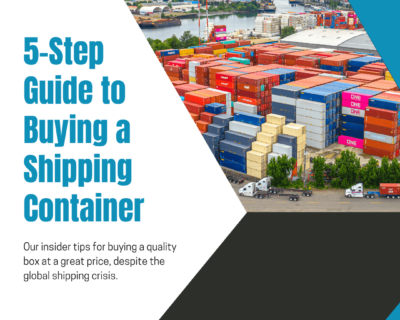News
The Ultimate Guide to Refrigerated or Reefer Shipping Containers
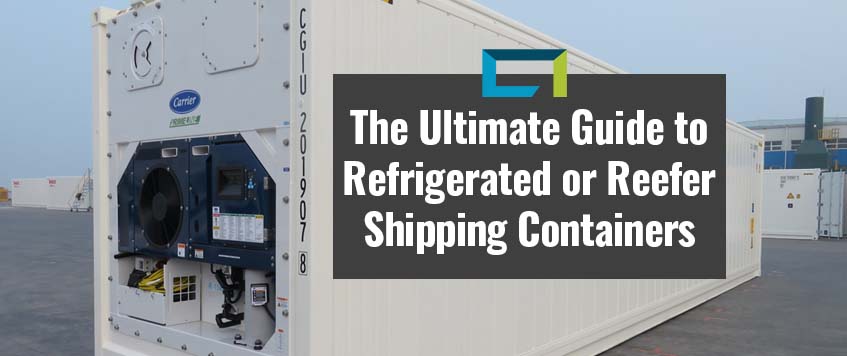
Are you looking to buy or rent a reefer or refrigerated shipping container? ITS ConGlobal sells and leases portable, electric, and energy-efficient cold storage units that can keep your stuff cool.
Our nationwide network stocks a full line of new and reconditioned containers in a variety of sizes and configurations. Whatever your need our boxes are durable and reliable for cold storage. We work hard to give you the best quality at the lowest price, and our team can provide a local quote in little as 24 hours. Request a quote now.
The terms “reefer container” and “reefer” are short for “refrigerated container.” These containers maintain a stable temperature while controlling humidity and promoting adequate airflow. Climate control functionality keeps products inside from spoiling, resulting from too much heat, excessive moisture, and insufficient airflow or temperatures that drop too low.
Temperature-sensitive materials, such as food and pharmaceuticals, require temperature control to maintain freshness during transport, and reefers containers ensure goods arrive in pristine condition. All standard reefers maintain a temperature between +30° C and -30° C for chilled and frozen cargo. A percentage of the global reefer fleet can maintain temperatures down to -35° C or even lower. Special containers or super freezers can maintain a temperature of -70° C.
Supply chain and chilled cargo
The cold chain industry saw rapid growth in 2020 due to the pandemic, and the distribution of the COVID-19 vaccine made cold chains one of the critical supply chain topics throughout 2021.
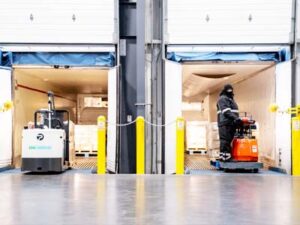
Cold chains are supply chains that specialize in the planning, storing, loading, and movement of temperature-sensitive products. Moving freight that requires temperature control involves many moving parts to work seamlessly.
When planning a cold shipment, the shipper and carrier must work together to select the correct equipment to transport the goods to their final destination. International shipping has significant hurdles to cross because products may require movement to different containers to comply with food safety standards, reducing the growth of bacteria, spoilage, and timely delivery.
Most LTL or less-than-truckload carriers maintain cold-storage staging depots that permit them to keep products outside their ‘danger zone’ temperature tolerance. When the shipment is ready for movement, freight carriers quickly load cargo in temperature-controlled containers.
Cold supply chains and customer demand
When consumers saw empty freezer cases in grocery stores, it was apparent that cold supply chains must move efficiently to keep up with consumer demand and the trend of stockpiling frozen food. Modern equipment and design ensure shipping containers are resilient, but freight damage risk exists because of shipping delays.

Consumer behavior dramatically changed after the pandemic, and as confidence grew in online grocery shopping, the need for more cold storage has surged. As the industry adjusts to the unprecedented demand for cold storage warehouses closer to the consumer, refrigerated reefers provide short-term storage solutions to offer relief.
The many uses of climate-controlled containers
Reefers have decades of use transporting perishable and delicate materials like meat, fish, dairy, vegetables, flowers and plants, blood plasma, film, and reagents for testing that would go bad during a long ocean crossing. While refrigerated shipping containers’ primary use is for moving cold cargo, there are many other uses.
Whether you want to rent a reefer or refrigerated container, ITSC has the solution to meet our customers’ unique needs. We offer temporary and long-term storage options for the domestic market. And we are always amazed to see the creative ways our customers use these cold storage units.

Our customers create instant cold rooms once their refrigerated container is delivered and plugged in. This option is particularly popular with festival and event organizers, restaurants, and grocery stores during peak seasons like Thanksgiving and Christmas.
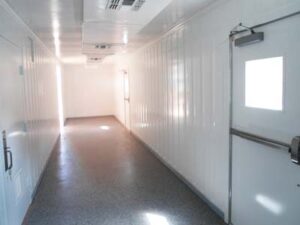
A reefer container makes an excellent mobile lab because it is secure, weatherproof, durable, and temperature controlled. The design and manufacturing of shipping container labs happen off-site, and the controlled environment is delivered ready for use.

When disaster strikes, a reefer shipping container can quickly move vast quantities of medicine, food, and other life-saving goods to bring relief to areas that have suffered a disaster.
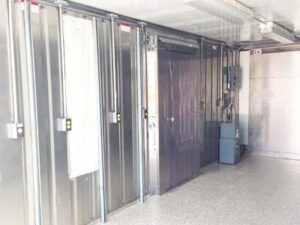
Refrigerated containers allow food banks to accept larger volumes of food. Storing goods in a temperature-controlled environment extends the shelf-life allowing the distribution of donated food goods to the community before spoilage.
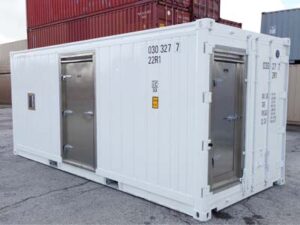
Customers transfer cold goods to refrigerated units during facility upgrades or store and quickly restock merchandise due to the supply chain disruption.

Southern states use refrigerated containers to store ice for concrete pours. Ice is far more effective at controlling concrete temperature than cold water. Using ice helps slow down the cement hydration process allowing the mixture to process and achieve optimal strength.
The types of reefer or refrigerated containers our customers buy or rent
Like standard one-trip containers, one-trip reefers have made only one trip across the ocean and will arrive in excellent condition with all components working reliably.
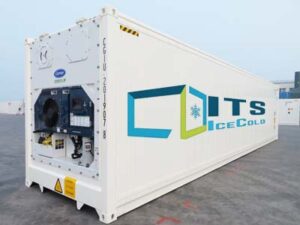
ITS ConGlobal offers brand new 10′, 20′, and 40′ reefers equipped with new Carrier refrigeration units. These units have stainless steel exteriors and interiors, and double rear doors. They can maintain -30° F to 80° F. Each new reefer we sell includes a 5-Year factory warranty.
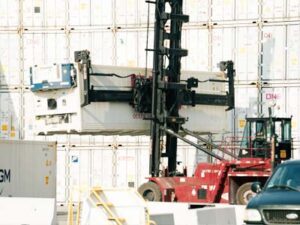
ITS ConGlobal also offers used seagoing refrigerated containers in two standard sizes, 20′ x 8′ and 40′ x 8′. Every used reefer container undergoes rigorous testing by our trained and certified onsite technicians, confirming that every unit can hold precise and consistent temperatures and we replace any questionable components.
You can trust the quality of our work, ITS ConGlobal is a certified dealer and service provider for the leading refrigeration companies Carrier, Thermoking, Daikin, and Starcool.
10-foot custom reefers are perfect when space is limited. The box ‘shell’ is all-new and is made to specification. These units feature stainless steel interior and exterior walls, and they are 10′ x 8′ wide by 8’6″ tall, with double doors at the rear. Add flexibility to off-shore rigs, transport boats, or barge applications by adding a sized-to-fit new or refurbished refrigeration machine. We have equipment rated for 460V and 40A services, and we also carry 15KVA and 230V options. We offer new Magnum units for customers who need a freezer or chiller temps from -35° C to 30° C.
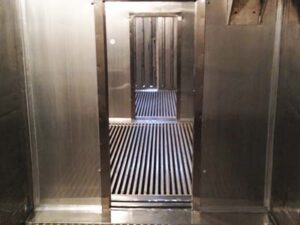
Multi-temperature (dual temp) reefers are great when storing frozen and chilled products in the same container. We modify one of our standard storage containers by installing a partition, making two compartments controlled separately. Want to add a section? No problem, slide the bulkhead accordingly.
As an industry leader, we can help you buy or rent a reefer or refrigerated container for your exact needs at a great price. Request a quote today.
The basic components of a reefer
Before we dive into the refrigeration components, it is vital to call out how the flooring system impacts the function and reliability of the reefer. There are two common types of floor for refrigerated trailers—flat flooring for pallets or refer duct also known as corrugated, T floors.
Walk-in storage or storage with shelving units works best with flat floors, and we see these floors used in restaurants or grocery stores. They are also suitable for using moveable diver walls called bulkheads to create multiple temperature zones because bulkheads can seal tightly on the floor surface. Flat floors are not prone to collecting debris or snag pallets and are easier to clean.
Reefer duct floors, also known as corrugated T floors, can serve a variety of loads. This aluminum flooring usually consists of extruded “T” planks running the entire container length. These slightly raised planks allow the air to circulate across the bottom of the container to the double doors and push air back to the refrigeration unit, maximizing airflow and even temperature distribution. T floors are rated for forklift traffic.
The basic components of a reefer refrigeration system
Refrigeration units consist of a compressor, controller, evaporator fans, fresh air vents, the unit evaporator, and condenser sections that operate together to maintain the temperature inside the container. All reefer containers also can heat their insulated interior using hot gas heat or electrical heating elements.
- Evaporator fans are located inside the reefer to circulate air and promote adequate temperature control and stability.
- The controller is a computer that manages setpoints for specific interior temperature, alarm conditions, and ventilation and humidity levels.
- The fresh air vent pulls air from the outside and allows gases inside the container, such as a riping agent ethylene gas, to leave the container.
- Excess moisture in a reefer can damage products, quicken food spoilage, and break down packaging. The evaporator section can either heat or cool the air circulating past the fan. In some instances, the reefer controls will switch between heat and cooling modes to maintain the desired internal temperature. The evaporator section pulls air from the top of the container and discharges it under the cargo, pushing air towards the back doors. The air rises and flows back over the load to the air inlet. Freight must be appropriately loaded and covered inside the container to allow airflow below the cargo preventing the ‘chimney’ effect or short cycling.
- Condensers are cooled by air or water. The most common type is air-cooled, and cooling happens in the external coil and fan of the unit.
- Reefer containers operate on 480V, 3 Phase electricity. If the supply voltage at a particular site is different, use a step-up Voltage transformer to provide proper voltage to the reefer. The most common step-up transformers are 230V to 480V and 208V to 480V. It is imperative to know the site voltage to supply the proper transformer. Supplying improper voltage can damage the reefer and reduce service life.
When refrigerated containers are transported on land by rail or truck, they don’t have access to power on a vessel, within the port, or at a container yard/depot. Instead, they rely on a generator set or Genset for powering their refrigeration components. There are two types of Gensets—a clip-on unit attached to the front or side of the refrigerated container and underslung Gensets, which mount beneath the frame on the chassis.
Maintaining your investment
Regular inspections and proper use, maintenance, and servicing are essential to keeping reefer containers in good shape and sound working order.
Pre-trip inspections are required to ensure customers receive safe and clean containers with efficiently functioning temperature-regulating machinery. ITS ConGlobal pre-trip inspections include high-pressure cleaning to remove dirt and odor, internal review to ensure the environment meets specifications like food grade, and machinery checks to ensure the proper functioning and industry standards.
Only use qualified technicians

Only qualified technicians should repair and maintain refrigerated containers to prevent temperature fluctuations and failures of a fully-loaded container. To maintain peak performance, here are a few tips:
- Periodic cleaning of reefer condenser coils using a water washout or compressed air.
- Clean floor drains of debris to ensure any water can drain from the interior.
- Monitor temperature readouts and monitor for displayed alarm codes.
- If your unit displays an alarm code, seek out service.
- Monitor the digital controllers that feed (air temp) and control signals.
- Minimize opening the door during use. If the door must remain open, turn off the unit at the main switch to minimize drawing in hot, moist air into the unit.
- Properly load your reefer taking care not to block airflow. Follow the indicated maximum stack height on the interior walls.
ITS ConGlobal offers full-service maintenance and repair for refrigerated containers, and our trained and certified technicians perform the work onsite. Our fully-stocked mobile service fleet allows our teams to perform in-service and emergency repairs at our location or yours. Learn more about our maintenance and repair options.
How to pack a reefer to guarantee goods arrive in pristine condition
When shipping refrigerated goods for a long journey, it’s critical to pack that cargo container to maximize its cooling abilities and avoid hot or cold spots. Following the simple principles below will help you avoid costly spoilage mistakes.
Pre-cool your cargo to shipping temperature. Each reefer shipping container comes with a refrigeration unit that helps keep the goods cold in transport from point a to point b. It doesn’t make sense to stuff room temperature or warmer cargo into a cooling unit. It will cause your reefer to work overtime and may affect the quality of the goods during travel.
Prep the container. Set the container to the desired temperature and vent setting. Keep the vents closed with frozen loads, and if you wish, open the vents with refrigerated loads. Opening the vents allows gases to escape that could otherwise affect your cargo’s freshness. Before packing your container, switch off the machinery to reduce condensation.
Begin packing or stuffing your cargo. To clarify, stuffing in this context refers to the skill or art of packing a refrigerated container to a maximum optimal capacity, not shoving, ramming, cramming, or forcefully filling something in. The type of goods and packaging will influence how the stuffing occurs so that air circulates appropriately through the packages.
Generally, there are two reefer cargo patterns to consider. Grouping goods together based on their specific destination is called block stowage. This method is often chosen for non-palletized goods and aims to speed up off-loading and minimize other goods’ disturbance in the same container. Palletized stowage refers to goods that are stowed securely onto a pallet. Box edges must align with the corners of the pallet, and it is imperative to position box air holes to support unrestricted airflow within the products.
Helpful tips for packing
Regardless of the goods, you are loading, here are some helpful tips to ensure the air within your refrigerated container is circulating correctly.
Do’s
- Pack cargo tightly and make sure it is stable to prevent shifting
- Set the unit at the correct temperature for the cargo
- Check the dehumidification controls
- Pre-cool the cargo if required
- Set correct ventilation settings
Don’ts
- Stow the cargo above the load line
- Stow cargo past the end of the T-floor
- Allow any restrictions to block the flow of air
- Pre-cool the container unless it’s in cold storage in an airlocked cold tunnel
- Allow gaps between the pallets and the door
Experts forecast the demand for dry and refrigerated to remain high in 2022 and beyond. As the leader in the container industry since 1968, ITS ConGlobal has the expertise and network footprint needed to source the equipment you need, where you need it for a competitive price.
Contact our expert cold storage team today for more information or to buy or lease a reefer or refrigerated container. We’re also happy to share our knowledge of temperature-controlled solutions.


